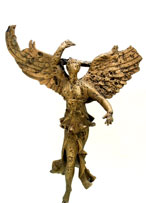| Author | |
|---|---|
| Epoch | XII-XIII |
| Work | The Man in the Panther Skin (Shota Rustaveli, The Man in the Panther Skin, Text and Versions, Edited by Akaki Shanidze and Alexandre Baramidze, Tbilisi, 1966) |
| Type | |
| Quote | “He said: ‘You, o sun, who they said to be the image (literally: the icon) of the Sunny Night, [The image] Of Multiple (literally: of Consubstantial) in One, of a Timeless Time, Whom celestial bodies obey to the jot of a second, Turn not away my good fortune; hear my prayer till our meeting, mine and hers’.” (837, 1-4) “You [sun], whom earlier philosophers addressed as the image (literally: the icon) of God, Aid me, […]” (838, 1-2) |
| Term |

| Comment | In N. Natadze’s opinion, “since in this line [838, 1] Rustaveli refers to ‘earlier philosophers’, we may think that here he is referring to Plato and the Neoplatonists rather than the Church Fathers, in contrast to the 1st line of the previous stanza ("You, o sun, who they said to be the image of […]" [837, 1]), where, together with pagan philosophers, the Church Fathers should also be implied” (see Shota Rustaveli, “The Man in the Panther Skin”, School Edition with Introduction, Literary Review, Dictionary and Commentary, Edited by N. Natadze, Tbilisi, II edition, 2006 (in Georgian), pg. 478). However, in my opinion, it is beyond any doubt that the verses 837-838 cannot be viewed separately from each other, as in this place of the poem we find the case of the so-called contact parallelism, which is one of the most typical artistic techniques used by Rustaveli (for details see: Z. Khintibidze, Homer and Rustaveli – The Homeric Principles of Compositional Organization and the Epic Tradition, Tbilisi, 2005, pg. 99…; in the present encyclopedia “the form of every body”). Thus, in the 837th stanza are implied the same persons as in the 838th stanza, that is, both places either relate to the pagan philosophers and the Church Fathers simultaneously, or both of these stanzas relate only to the pagan philosophers. At the same time, the contact parallelism found in this place of the poem clearly points to the fact, that the words - “Sunny Night”, “Multiple (literally: of Consubstantial) in One” and “Timeless Time” from 837th stanza, is identical to the word - “God” from the 838th stanza and thus, God cannot be implied under the “Sun” per se, as according to both of the stanzas under consideration, the “sun” itself, as a luminary body, is not God / the Supreme Being, but it is only “the icon of the God” (see E. Khintibidze, The World View of Rustaveli’s Vepkhistqaosani (The Man in the Panther Skin), Tbilisi, 2009, (in Georgian), pg. 288, see in details pg. 240-288; cf. N. Natadze, op. cit., pg. 252). There is only one more thing to be clarified, namely, according to which philosophical doctrine or religious belief is “the sun the icon of God”. But as it turns out, such doctrines or religions are many. Thus, e.g. in N. Natadze’s opinion (see N. Natadze, op. cit., pg. 478) it can be Plato himself or Neoplatonists, as well as Church Fathers and Pseudo-Dionysius the Areopagite. With regard to the names of “The Man in the Panther Skin’s” Supreme Being / God found in the passage under consideration (“Sunny night”, “Multiple (literally: of Consubstantial) in One” and „Timeless Time”), as E. Khintibidze concludes, “they are the concepts created by means of the so-called positive-negative dialectics” (see op. cit., pg. 279); “all the three names are based on the well-known philosophical method (kataphatic-apophatic) for the perception of God, which was generally accepted in ancient religious and philosophical systems” (see ibid.: pg. 288, also pg. 262-263). So, e.g., according to the researcher’s observation, “this epistemological method […] was not alien to the father of dialectics, Heraclitus of Ephesus”. One of his “fragments preserves a name of the deity, which is closer to Rustaveli’s ‘Sunny Night’ than any other parallel discovered to date; in Heraclitus’ explanation /fragm. 67 (36)/, God is ‘day and night’. However, Rustaveli refers only to the philosophical method - kataphatic-apophatic, by means of which he forms the names of God. […] When we try to find exactly the source of Rustaveli’s above-said thinking, we must divert our attention first of all to the teaching of Pseudo-Dionysius the Areopagite […]” (for details see op. cit., pg. 263-264). Thus, taking into account all the above mentioned, in my opinion, “earlier philosophers” should be understood as generally the “philosophers of the past”, i.e., those before Rustaveli and not necessarily only those who had lived before Christ, that is, the pagan intellectuals. [Z.Kh.] |
|---|

